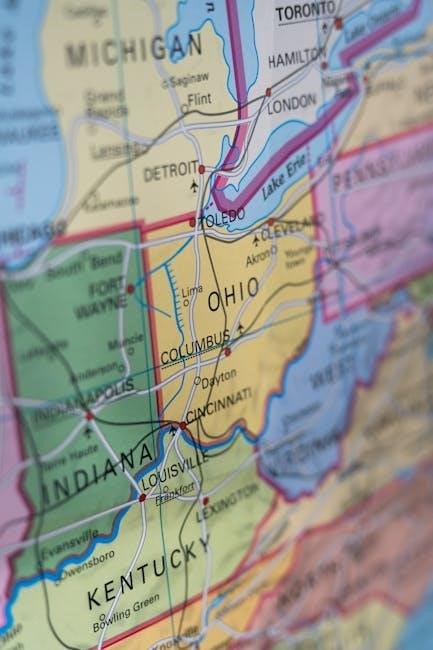This AP Gov Unit 1 Study Guide provides a comprehensive overview of foundational concepts, including democratic principles, Enlightenment influences, the Declaration of Independence, Constitution, and federalism. It offers detailed explanations, key terms, and study strategies to help students master the material effectively.

Fundamental Principles of Democracy
Democracy relies on core principles like popular sovereignty, rule of law, and individual rights. It includes direct and representative democracy, ensuring citizen participation and fair governance structures.
2.1. Types of Democracy
Democracy exists in two primary forms: direct and representative. In direct democracy, citizens make decisions themselves through votes or assemblies, ideal for small, homogeneous societies. Representative democracy involves electing officials to make decisions on behalf of the people, suitable for larger, diverse populations. Other variations include constitutional democracy, which limits government power via a constitution, and participatory democracy, emphasizing active citizen involvement. Each type balances participation, efficiency, and protection of rights, shaping governance structures worldwide.
2.2. Key Concepts: Popular Sovereignty, Federalism, Republic, and Individual Rights
Popular sovereignty asserts that political authority derives from the people, a foundational principle of American democracy. Federalism divides power between the national government and states, ensuring balanced governance. A republic, unlike a direct democracy, relies on elected representatives to act in citizens’ interests. Individual rights, protected by the Constitution, ensure freedoms like speech, religion, and due process. These concepts collectively form the framework of the U.S. government, emphasizing accountability, decentralization, representation, and personal liberties. Understanding these principles is crucial for grasping the structure and function of American democracy, as outlined in the AP Gov Unit 1 Study Guide.

The Enlightenment Period and Its Influence
The Enlightenment emphasized reason, natural law, and individual rights, shaping American democracy. Its ideas influenced the Declaration of Independence and Constitution, fostering liberty and limited government.
3.1. John Locke and the Social Contract
John Locke, a prominent Enlightenment thinker, significantly influenced American democracy through his ideas on natural rights and the social contract. Locke argued that individuals are born with inherent rights to life, liberty, and property, which governments are established to protect. The social contract theory posits that citizens consent to be governed in exchange for protection of their rights. If a government fails to uphold these rights, Locke asserted that people have the right to revolt. His ideas were foundational to the Declaration of Independence and the U.S. Constitution, shaping principles like popular sovereignty and limited government. Locke’s emphasis on individual rights and consent of the governed remains central to American political philosophy.
3.2. Jean-Jacques Rousseau and the General Will
Jean-Jacques Rousseau, another key Enlightenment thinker, introduced the concept of the “general will,” which refers to the collective moral and political will of a society; Unlike Locke, Rousseau emphasized the community’s interests over individual rights. He believed that citizens should subordinate their personal desires to the common good, as expressed through the general will. Rousseau argued that this collective will is expressed through the democratic process, where the majority’s decisions reflect the community’s best interests. While his ideas were less directly influential on American democracy compared to Locke, Rousseau’s focus on community and collective decision-making has had lasting impacts on political theory and discussions about democracy.
3.3. Montesquieu and the Separation of Powers
Charles de Montesquieu, a French Enlightenment thinker, is renowned for his theory of the separation of powers. He proposed dividing government into three distinct branches: the legislative, executive, and judicial. This division was designed to prevent any single entity from abusing power, ensuring checks and balances. Montesquieu’s ideas significantly influenced the U.S. Constitution, particularly James Madison, who incorporated these principles into the framework of the American government. By separating powers, Montesquieu aimed to protect individual liberties and promote political stability; His work remains a cornerstone of modern democratic governance, emphasizing the importance of balancing power to prevent tyranny and safeguard freedom.
3.4. Enlightenment Ideas’ Impact on American Government

Enlightenment ideas profoundly shaped the foundation of American government. Concepts like reason, natural rights, and social contracts influenced the Declaration of Independence and the U.S. Constitution. The emphasis on individual rights, popular sovereignty, and the consent of the governed became central principles. Enlightenment thinkers inspired the system of checks and balances and the separation of powers, ensuring no single branch of government could dominate. These ideas also promoted the belief in limited government and the protection of civil liberties. The Founding Fathers drew directly from Enlightenment philosophers, applying their principles to create a democratic system unique to the American experience. Understanding these influences is crucial for grasping the origins and evolution of American democracy, making them a key focus of AP Gov Unit 1 studies.

The Declaration of Independence
The Declaration of Independence, adopted in 1776, formally declared the colonies’ independence from Britain. It outlined democratic ideals, listed grievances against the king, and established the foundation for American sovereignty, shaping the nation’s political identity.
4.1. Main Ideas and Democratic Ideals
The Declaration of Independence presented core democratic ideals such as natural rights, popular sovereignty, and the social contract. It emphasized that governments derive their power from the consent of the governed and must ensure life, liberty, and the pursuit of happiness. These principles, influenced by Enlightenment thinkers like John Locke, established the foundation for American democracy. The document also asserted the colonies’ right to self-governance, challenging absolute monarchy and feudal traditions. By declaring these ideals, the Founders set a precedent for future democratic movements worldwide, shaping the political philosophy of the United States and its commitment to individual rights and freedoms.

4.2. List of Grievances and Their Significance
The Declaration of Independence included a detailed list of grievances against King George III, highlighting abuses of power and violations of colonial rights. These grievances aimed to justify the colonies’ separation from Britain and establish moral legitimacy for independence. Key complaints included taxation without representation, the imposition of laws without consent, and the denial of a fair trial by jury. The document also criticized the Quartering Acts, which forced colonists to house British soldiers, and the restriction of colonial expansion. These grievances demonstrated the colonies’ commitment to principles of liberty and self-governance, laying the groundwork for the democratic ideals embedded in the U.S. Constitution and Bill of Rights.

The Constitution
The Constitution establishes the framework of the U.S. government, outlining its structure, powers, and limitations. It includes the Preamble, Seven Articles, and the Bill of Rights, ensuring federal authority and individual liberties.
5.1. Structure, Preamble, and Purpose
The Constitution is structured with a Preamble and seven Articles, establishing the framework of the U.S. government. The Preamble outlines the document’s objectives, such as forming a more perfect union and ensuring domestic tranquility. The Articles detail the separation of powers among the legislative, executive, and judicial branches, and define federal authority and individual rights. The Constitution’s purpose is to create a unified government system while protecting citizens’ liberties. It balances federal power with state sovereignty, ensuring stability and justice. The structure reflects Enlightenment principles like checks and balances, influencing American governance. This foundational document has been amended to adapt to societal changes, maintaining its role as the supreme law of the land. Understanding its structure and purpose is essential for grasping U.S. democracy.
5.2. The Seven Articles and the Bill of Rights
The Constitution consists of seven Articles, each addressing specific aspects of governance. Article I establishes the legislative branch, while Articles II and III define the executive and judicial branches, respectively. Articles IV, V, VI, and VII cover state relations, amendments, national supremacy, and ratification. The Bill of Rights, comprising the first ten amendments, ensures individual freedoms such as speech, religion, and the right to bear arms. These amendments safeguard citizens’ liberties and limit government overreach. Together, the Articles and the Bill of Rights form the backbone of the U.S. legal system, balancing federal authority with personal rights. Understanding these components is crucial for analyzing the framework of American democracy and the protections it affords. This section provides a clear overview of the Constitution’s structural and protective elements.

Federalism and the System of Government
Federalism is a cornerstone of the U.S. governmental system, dividing power between the federal government and state governments. This division ensures a balance of authority, preventing centralized control while allowing states to maintain autonomy. The Constitution establishes this framework, with the Supremacy Clause asserting federal authority over state laws when they conflict. Federalism promotes state innovation and tailored policies, enabling local governance to address regional needs. Key principles include dual sovereignty, shared powers, and the 10th Amendment, which reserves powers not delegated to the federal government for the states. Historical developments, such as the Commerce Clause and judicial interpretations, have shaped federal-state relations. Understanding federalism is essential for analyzing the interplay between national and state governments in the American political system. This section explores the origins, evolution, and implications of federalism in governance.

Study Tips and Strategies for Unit 1
Mastering Unit 1 requires a structured approach. Begin by outlining key concepts like democracy, Enlightenment ideas, and federalism. Use active recall to test yourself on terms and ideas. Create concept maps to visualize relationships between principles, such as popular sovereignty and republicanism. Focus on primary sources, like the Declaration of Independence, to grasp foundational ideals. Self-quizzing on significant Supreme Court cases or Enlightenment thinkers can reinforce understanding. Summarize notes in your own words to enhance retention. Utilize flashcards for terms like “Montesquieu” or “separation of powers.” Prioritize challenging topics and allocate study time accordingly. Engage with practice questions to simulate exam conditions. Stay organized and review consistently to build a strong foundation for the unit.
